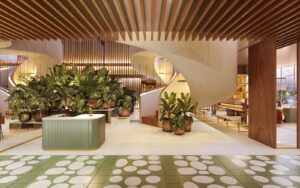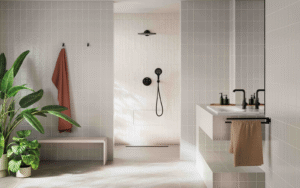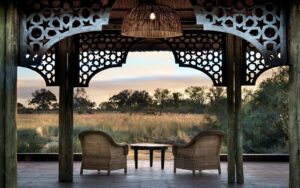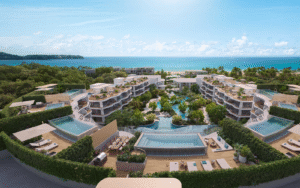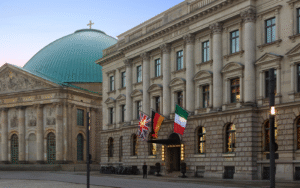Public spaces are the first areas guests are exposed to, so expectations need to be met from the outset to craft the desired emotional responses. We caught up with hospitality lighting experts Northern Lights to uncover what goes in to creating a successful lighting scheme for public spaces…
When it comes to lighting requirements, every hotel is different. The lighting scheme needs to be expertly tailored to suit the hotel’s unique demands and architecture.
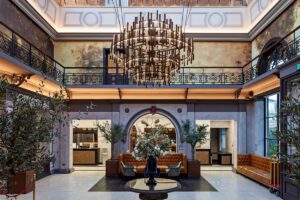
Image caption: Oatlands Park Hotel | Image credit: Northern Lights
A unique experience
The hotel foyer or lobby instantly symbolises the level of quality the hotel sets out to deliver. Bespoke lighting is commissioned to set the tone and deliver a unique experience, incorporating exquisite materials such as glass, crystal and alabaster and often complex structures and shapes. Lobby lighting plays an integral part in reinforcing the hotel brand’s concept and appeal, and making guests feel instantly welcomed and positive about their stay. Buildings that benefit from vaulted ceilings and large open spaces can accommodate dramatic, large-scale lighting solutions that set the tone for a luxurious and unique experience.

Image caption: Hilton London Croydon | Image credit: Northern Lights
Maintaining the concept
“Statement lighting within public areas provides an opportunity for the operator and designer to originate and realise designs which can harmonise with the aesthetic of the space. We’re able to help our clients achieve a level of consistency within such unique pieces through a variety of techniques,” explained Michael Jackson, Head of Design at Northern Lights.
“We have an extensive catalogue of finishes and often create custom finishes to match other elements in the scheme. From hand-applied artisan patinas to matching to project-specific RAL colours, we have the ability to replicate colours and finishes in various materials,” continued Jackson. ” This enables a homogenous coordination of design elements across the interior scheme, allowing hotels to achieve brand consistency. This can also be achieved through material and shade selection, shapes, detailing and trims. These techniques enable designers to develop uniqueness throughout the lighting scheme whilst retaining a design approach that connects the different public area spaces.”
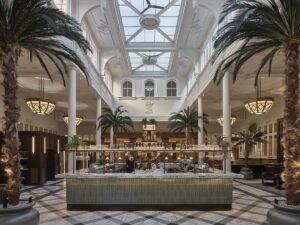
Image caption: Municipal Liverpool | Image credit: Northern Lights
Incorporate natural light
Incorporating natural light sources into the overall lighting scheme requires careful attention to detail. How and where light spills into the different areas at different times of the day impacts how the rest of the lighting needs to be approached. Considering colour temperature and even distribution of all lighting sources allows control over how the spaces are perceived and used by guests throughout their stay.
Adapting to multi-function layouts
Rigid, defined spaces separating lobby, reception, bar and relaxing areas are evolving into more open, multi-functional spaces. Lighting controls allow hotel staff to adjust or set lighting to fit with the different uses at different times of day. For example, using cooler lighting and maximising natural daylight from skylights and windows is ideal for breakfast, where more intimate, warmer lighting can be used along with dimming controls later in the day to encourage guests to relax in the bar, restaurant or lounge areas.
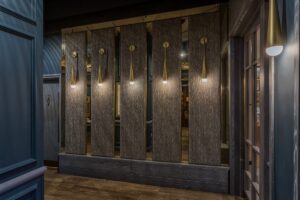
Image caption: Sopwell House | Image credit: Michael Franke
Hallway lighting
Creating illuminated pathways promotes spatial awareness of the hotel as guests navigate through corridors that connect each part of the building. Wall lighting and lamps in these areas create a sense of comfort and connection. These spaces need to balance, providing enough light in darker hallways where no natural light is present, with aesthetic and emotional layers to maintain the overall ambience and feel of the hotel.
Invest in quality
Functionality must go together with visual appeal in every area of the hotel. Material choices and design integrity are equally as important as aesthetics when designing lighting for high-demand hospitality settings. Using robust, durable materials selected specifically for hotels will ensure longevity. Designs can be approached in a way that makes them easy to clean, maintain, and parts to be repaired or replaced; an important factor for hotel operators that can sometimes be overlooked.
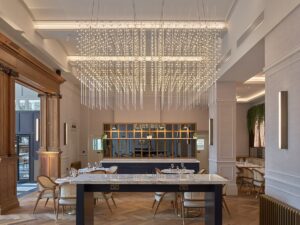
Image caption: the Municipal | Image credit: Northern Lights
Balance lighting functions
Task lighting is essential for hotel staff to carry out functional tasks, such as the reception area, or reading corners for guests to relax. Task lighting is often associated with spotlights and other minimal functional lighting solutions. However desk lamps and hanging pendants with considered brightness levels can provide functionality with additional visual appeal. Ambient lighting provides the primary source of light for public spaces through a mixture of chandeliers, pendants and wall lights, adding depth, warmth and the core visual appeal. Accent lighting is used to draw focus to architectural details, décor and art pieces, celebrating beauty within. Layering of these lighting types and incorporating both diffused and directional solutions creates balanced, harmonious lighting scheme.
Northern Lights is one of our Recommended Suppliers and regularly features in our Supplier News section of the website. If you are interested in becoming one of our Recommended Suppliers, please email Katy Phillips.
Main image credit: Northern Lights






